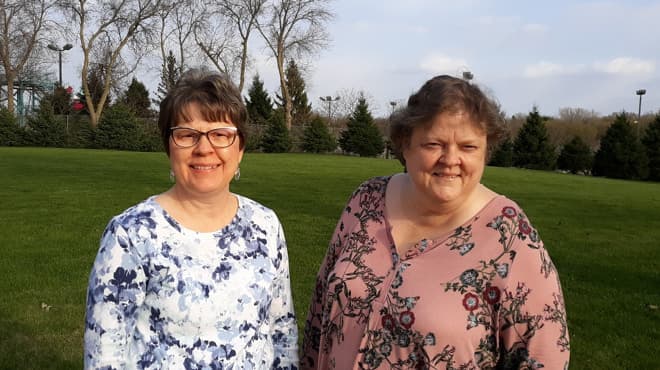Recent Posts
-

-
 Patient StoriesA lifesaver saved: An EMS veteran’s journey from rescue to recoveryNovember 14, 2025
Patient StoriesA lifesaver saved: An EMS veteran’s journey from rescue to recoveryNovember 14, 2025 -

Orthopedic expertise powers Tom Brown's epic trek

When people retire, they often plan to spend more time with their grandkids, or on activities like volunteering, gardening, traveling and hobbies. Christine Brown came up with something far more epic.
After thinking about what she and her husband, Tom, enjoyed doing together, she proposed that they spend the next five years hiking the 2,190 miles of the Appalachian Trail (AT). Stretching from Springer Mountain, Georgia, to Katahdin, Maine, it's the longest hiking-only trail in the world.
Tom's response was, "Absolutely!"
Retirement challenge: Tackling the Appalachian Trail
So in 2018, the La Crosse, Wisconsin, couple laced up their boots, hoisted their backpacks, grabbed their hiking sticks and headed north from the trail's southernmost point. Their five-year plan called for hiking the Appalachian Trail in 400- to 550-mile segments. That schedule meant 12 to 18 miles per day over rough terrain, up and down mountains through all kinds of weather, from sweltering heat to snow and sleet. According to the Browns, that breaks down to 30,000 to 40,000 steps a day.
"It's a physical challenge, but it's also a mental challenge," says Tom. "Some days, you see quite a few hikers; on other days, you're completely alone. Some days, the hiking is challenging, and some days you're walking down a small town's Main Street. You meet people of all backgrounds and ages on the AT. The hikers become a community and are always willing to help each other."
Even before the start of their epic trek, Tom, 63, had been experiencing pain in his right knee brought on by years of work at his excavating and snowplowing business. He'd undergone hyaluronate injections to relieve the pain and help the joint move more smoothly. Those treatments meant the pain wasn't enough to delay or trim back their plan.
Then came May 2022.
A slippery stone leads to surgery
Christine, whose trail name is Beanbuster, and Tom, whose trail name is Traverse, were hiking the Appalachian Trail as it wove through the Green Mountains of Vermont. It was a drizzly day. They were climbing up a mountain, and the stones underfoot were slippery. A stone shifted, and Tom felt something stretch and pop: the Achilles tendon in his right leg.
The couple worked their way to a hotel, began icing the tendon and contacted primary care provider in La Crosse, for advice on caring for the injury. The Browns decided to head home and a few days later, Tom's Achilles tendon ruptured. Repairing the tendon now took precedence over his aching, arthritic knee.
To address this critical injury, which turned out to be particularly complicated, Tom reached out to Charles Nolte, D.O., his long-time orthopedics specialist, who practices at Mayo Clinic Health System in La Crosse and Onalaska, Wisconsin.
"This wasn't just an Achilles rupture," Dr. Nolte says. "Tom had a completely calcified tendon, probably due to an earlier injury. We had to perform a complex reconstruction of the tendon, which involved cutting out much of it, then reconnecting it."
Dr. Nolte says they weren't sure if the tendon would heal, much less heal well enough for Tom to return to the trail. Dr. Nolte told Tom it would be a slow recovery. But Tom tackled his rehabilitation and recovery with the same can-do spirit as he tackled the trail with Christine.
"At one point, there was no guarantee if the surgery would hold, if I'd have a drop foot or get my range of motion back," he says. "The physical therapists knew I wanted to be back on the AT by May 2023, so they set up a program that focused on strength, range of motion and stretching the tendon. They kept me on track and didn't let me get ahead of my healing."
Time to address chronic pain
After six months of recovery from the Achilles rupture, it was time to start phase two of Tom's plan to get back to the trail: a total replacement of his right knee.
"Tom had dealt with his arthritic right knee for years and undergone nonoperative treatments to relieve the pain," says Dr. Nolte. "We planned to do a total knee replacement during his off-season from the trail, but then the Achilles rupture happened."
In February, Dr. Nolte performed a robotic-assisted total knee replacement of Tom's right knee.
"The robot takes a really good, successful procedure and makes it better," says Dr. Nolte. "The accuracy of cuts and component alignment are close to perfect, which reduces pain and speeds recovery."
Dr. Nolte adds that after completing about 300 robotic-assisted total knee replacements, he's seen a considerable difference in the postoperative recovery phase, with patients getting back more quickly to what they love to do.
Once again after surgery, Tom went into aggressive rehabilitation mode, following the plan of his physical therapists, and buying an exercise bike to continue building strength and range of motion at home. His goal was to be back on the Appalachian Trail by early May.
"I want to thank Dr. Nolte and my physical therapists, Katie [Crowley] and Roy [Eggart] in Onalaska, for all they did to help me reach my goals," Tom says. "They were amazing."
Dr. Nolte also credits Tom with doing the hard work to get better.
"Tom's a highly motivated patient. He did physical therapy before and after both surgeries, and followed his recovery plans," says Dr. Nolte. "Christine is a real go-getter, and he wanted to make sure he could keep up with her."
Postcards to the hometown care team
On May 5, almost one year to the day since his Achilles injury and less than three months since his knee replacement, Tom and Christine were back hiking a grueling 400-mile segment of the Appalachian Trail, including summiting 6,288-foot-high Mount Washington in New Hampshire's White Mountains during a snow and sleet storm.
"We had two weeks of nice weather," says Christine, "followed by five-and-a-half weeks of rain."

Despite the weather and continual up-and-down mountain climbing, Christine noticed a difference in Tom.
"He had been in pain for a long time with that knee. Pain is insidious, and affects you physically and mentally," she says. "It was great having my cheerful, good-humored husband back."
Throughout their 2023 trek of the trail, Christine sent postcards to Dr. Nolte. He shared the cards with his team members, who took pride and satisfaction in Tom's accomplishments. While the scenes on the cards varied, the message was always the same: "Dear Dr. Frankenstein-Nolte. Your surgery was such a success that you've created a monster. My husband sees a mountain, wants to climb it and makes me go with him. I'm cold and tired. Make him stop. Christine."
Christine will get her wish in June 2024 when she and Tom reach Katahdin, Maine, and officially complete the last 170-mile segment of their epic trek. To mark making it to the trail's end, they're planning to fly family members to Bar Harbor, Maine, for a grand finale celebration of their great adventure on the Appalachian Trail.


